
27 Journal of Economic and Banking Studies
No.7, Vol.4 (1),June 2024 pp. 27 - 38
© Banking Academy of Vietnam
ISSN 2734 - 9853
The impact of digital transformation on credit risk of
commercial banks in Vietnam
Doan, Viet Thang - Hoang, Thi Ngoc Anh - Phung, Trang Linh - Nguyen Thu Huong
Finance Faculty, Banking Academy of Vietnam
* Corresponding Authors
E-mail address: thang.dv509@gmail.com (Doan, V.T.), hnanh12123@gmail.com (Hoang, T.N. A.), tranglinh.
study@gmail.com (Phung, T.L.), ngthhuong8303@gmail.com (Nguyen, T.H.)
1. Introduction
Digital transformation in economic
sectors is an inevitable trend and is
considered one of the most important
characteristics of commercial banks - one of
the strategies to compete in the era of technol-
ogy. Vietnam has been increasing its global
presence and participating in shaping global
policies and initiatives, which makes digital
transformation more accessible and viable. On
May 11, 2021, the Governor of the State Bank
of Vietnam approved the digital transforma-
tion plan until 2025 along with the strategy for
developing the Vietnamese banking industry
(Decision No. 986/QD-TTG dated August 8,
2018) and the Prime Minister’s national digital
transformation program to 2025, orientation
to 2030 (Decision No. 749/QD-TTG dated
June 3, 2020). The research used the informa-
tion technology development and application
readiness index (ICT Index) to evaluate digital
Chronicle Abstract
Article history In Vietnam, digital transformation has been considered as the leading strat-
egy of commercial banks, especially in terms of credit risks. Therefore, they
must identify how their digital transformation affects their credit risks to
maintain effective operation and steady growth in a complex and chang-
ing market environment. Our study takes 29 commercial banks in Vietnam
from 2014 to 2022 as the research object to test the impact of bank digital
transformation on credit risk. In particular, the level of digital transforma-
tion of banks is measured by the ICT Index. The ICT Index is the official
measure that evaluates the level of information technology application na-
tionwide each year, with separate indicators for ministries and branches.
Banks in Vietnam also use the ICT Index to assess their readiness and abil-
ity to apply information technology in the digital transformation process.
Various regression models including Pooled Ordinary Least Squares (OLS),
Fixed Effects Model (FEM), Random Effects Model (REM), Generalized Least
Squares (GLS) are applied using STATA 17. Research results show that credit
risk is affected by 5 factors: the information technology development and
application readiness index (ICT Index), inflation rate (INF), return on equity
(ROE), loans to customers (LOAN), and operational diversification (NIIC).
On that basis, the study proposes recommendations for commercial banks
to promote their digital transformation process. In addition, the state and
policymakers also have appropriate measures to promote digital transfor-
mation in the Vietnamese banking system.
Received
Revised
Accepted
25th Nov 2023
1st Jan 2024
10th May 2024
Keywords
Digital transformation,
Credit risk,
Commercial banks,
ICT Index
DOI:
10.59276/JEBS.2024.06.2628

The impact of digital transformation on credit risk of commercial banks in Vietnam
28
Journal of Economic and Banking Studies- No.7, Vol.4 (1), June 2024
transformation and its effect on credit risk at
commercial banks in Vietnam.
Yao et al. (2020) argue that digital transac-
tions and digitization are necessary for their
economic and financial future with the bank-
ing sector being considered the most important
source of economic growth. economic for a
country. Digital transformation is about using
digital technology to change business models,
providing new facilities to increase income
and create value. Convert some changes af-
fect the way banks operate as well as internal
process structure and design (Garner, 2022).
With positive and potential transformational
effects changing numbers, a few studies have
also been initially analyzed such as Cheng and
Qu (2022), Cao et al. (2023), Li et al. (2022).
The impact of digital transformation in limiting
and controlling bank risk control. These stud-
ies looked at risk below different angles from
credit risk, default risk to capital safety level.
However, these studies section large concentra-
tions in the Chinese market while in Vietnam
there has been only one research related to
digitalization and bank credit risk.
According to research by Quang, N. T. T.
(2023), digital transformation does not reduce
banks’ credit risk, on the contrary it increases
credit risk. The main reason is because digital
transformation in banking activities in Vietnam
is still in the early stages to increase conve-
nience and service experience for customers.
Credit risk arises mainly due to the increase
in loan scale thanks to the positive influence
of digital transformation. In fact, credit risk at
banks is still a huge challenge that has not been
fully resolved. This situation not only affects
the stability of the financial system but also
creates significant pressure on the central bank.
The study highlights the challenges that banks
need to consider during the digital transforma-
tion process, specifically credit risk manage-
ment to be able to take full advantage of the
benefits brought by digital transformation.
Therefore, enhancing credit risk management
is key to ensuring safety and transparency in
banking operations, creating an urgent need for
detailed research on how digital transformation
can affect management credit risk of commer-
cial banks in Vietnam. Commercial banks also
need to accelerate the speed and level of digital
transformation to achieve comprehensive digi-
talization of their operations, thereby enhanc-
ing risk management effectiveness.
In the background of commercial banking in
Vietnam, credit risk is becoming increasingly
important, and digital transformation could not
be more widespread to address these chal-
lenges. Digital transformation not only helps
improve risk assessment and management
processes but also opens new opportunities in
credit management (Quang, N. T. T., 2023).
However, there has not been much research
related to this issue before so there also exist
some gaps in: time effects, accurate measure-
ment methods, industry comprehensiveness,
and specific risk estimates. Although digital
transformation brings with it the expectation
of positive effects on banking operations, it re-
quires a significant amount of time. This digital
transformation process in banking has been
recorded annually by the central, showing the
relationship between time and performance.
There may initially be a period of reduced
productivity due to delays as the bank needs to
gradually adapt to the new system, and staff also
need time to learn and apply new digital skills.
Based on a panel data set from 29 banks in
Vietnam from 2014 to 2022, the study evalu-
ated the impact of digital transformation on
credit risk for Vietnamese commercial banks.
From the results, the study makes some recom-
mendations for Vietnamese commercial banks
in the digital transformation process.
From understanding and updating the recent
research, we have made some recommenda-
tions to help commercial banks anticipate and
manage digital transformation challenges,
while ensuring they can take advantage of the
full potential of digitalization after the initial
difficult period. Taking a closer look at the
digital evolution, this study aims to understand
how technological advancements are affecting
the credit risk landscape of commercial banks
in Vietnam to provide a comprehensive and
detailed view of this issue and how they can

Doan, Viet Thang - Hoang, Thi Ngoc Anh - Phung, Trang Linh - Nguyen Thu Huong
29
No.7, Vol.4 (1), June 2024- Journal of Economic and Banking Studies
be exploited to optimize risk management and
efficiency in the field.
Our article includes the 5 sections as follows:
(1) Introduction; (2) Literature review; (3)
Research method; (4) analyzing and discussing
research results; and the final section is conclu-
sion and recommendations.
2. Literature review
With the development of science and tech-
nology and fierce competition from Fintech
companies, the digital transformation process
in banks is gradually becoming an inevitable
trend. Digital transformation in banking is the
process of bringing technology into banking
operations to increase customer experience,
understand customers and provide personal-
ized products and services to each customer
at any time that customers need to use them
(Thuy, N. V. (2022). According to Ernst and
Young (2017), digital transformation helps
banks improve customer experience on digital
platforms, increasing attractiveness and ability
to reduce transaction costs. When implement-
ing digital transformation, banks need to focus
on promoting improvements in non-customer
contact processes rather than improving direct
customer contact processes. Research by Van
Thuy, N. (2021) has shown that digitalization
has a significant impact on the performance of
banks. Many studies have shown the positive
impact of digital transformation in banking
on limiting and controlling risks. Fuster et al.
(2018) argue that innovations from financial
technology help reduce labor needs, capital
costs and time, increase data accuracy, thereby
reducing operational and system risks. Bank
operations have also become more flexible
and secure due to financial technology innova-
tions that help reduce the risk of information
asymmetry between banks and customers as
well as reduce default risk in lending activities
(Gomber et al., 2017). Increasing the appli-
cation of information technology in lending
activities also helps improve the ability to
evaluate loans before, during and after lending,
thereby reducing the risk (Sutherland, 2018).
In addition, Cheng et al. (2020) investigated
the impact of bank fintech on credit risk in
Chinese commercial banks. The research con-
cludes that bank fintech significantly reduces
credit risk across Chinese commercial banks.
Furthermore, their analysis suggests a weaker
negative association between bank fintech and
credit risk for large banks, state-owned banks,
and listed banks.
As for credit risk, it could be understood as the
risk that the bank faces when the borrowers
(customers) cannot fulfill the debt obligation
on the due date or at maturity. According to
Giesecke (2004), credit risk is by far the most
significant risk that banks face and the success
of their business depends on the accurate mea-
surement and effective management of risk.
This is to a greater extent than any other risk.
Similarly, Coyle (2000) defines credit risk as
loss due to credit customers’ refusal or inability
to pay the debt in full and on time.
Many factors affect the credit risk of banks,
as indicated by the research of Hang, H. T. T.
(2020), and Quynh, N. T. N. (2018). Specifi-
cally, in their study, Hoang Thi Thanh Hang et
al. (2020) built a model of 8 variables affecting
credit risk, but the research results showed that
only 5 of them were accepted and directly had
an impact on bad debt. Similarly, Quynh, N.
T. N. (2018) also pointed out that, at a statisti-
cal significance level of 1%, economic growth
rate, bank credit growth, and unemployment
rate had an inverse relationship with the bad
debt ratio. In addition, the inflation rate and the
previous year’s bad debt ratio were positively
correlated with the current bad debt ratio. In
contrast, the relationship between bank size
and profitability and the bad debt ratio had not
been found. Baselga-Pascual et al. (2015) also
employ a panel data approach spanning 2005
to 2011 to analyze the determinants of credit
risk in the Eurozone. The study finds that less
competitive markets, lower interest rates, and
economic crisis (falling GDP and rising infla-
tion) all contribute to heightened credit risk.
The robustness of these findings is confirmed
through various checks, including alternative
statistical methods and different risk measures.

The impact of digital transformation on credit risk of commercial banks in Vietnam
30
Journal of Economic and Banking Studies- No.7, Vol.4 (1), June 2024
One noteworthy exception is bank size, which
exhibits ambiguous effects across the tests.
This inconsistency, coupled with the high
significance levels and ongoing debate sur-
rounding size’s impact on risk, warrants further
investigation.
According to the research mentioned above,
they have initially analyzed the impact of
digital transformation on bank risks. Regarding
the relationship between digital transformation
and credit risk in the banking sector, Bahillo et
al. (2016) clarified that digital transformation
in credit risk management brings more trans-
parency for risk reports. On the contrary, some
scholars argue that banking digitalization could
have a negative impact on banking operations
and thus credit risk. For example, Starodubtse-
va et al. (2021) point out that digitalization has
negative consequences, especially in current
scenarios, such as commercial banks spending
more money on developing technologies, train-
ing employees, information security, workforce
issues, which may negatively impact credit
risk. Similarly, Quang, N. T. T. (2023) also
believes that digital transformation does not
reduce banks’ credit risks.
Overall, while there have been numerous studies
globally examining the relationship between
digital transformation and credit risk, in Viet-
nam, there is a paucity of research on this issue.
Furthermore, previous studies have primarily
focused on data from earlier periods, leading
to a lack of updated information. Additionally,
the majority of research papers do not provide
specific solutions for banking organizations.
This has created the objective for our research
team. Based on data from banking organizations
and available datasets on ICT readiness and
development (ICT Index), this study conducts
an empirical assessment of the impact of digital
transformation on the competitive advantage in
credit risk of commercial banks in Vietnam dur-
ing the period of 2014-2022.
3. Methodology and data
3.1. Methodology
In Vietnam, digital transformation has been
considered as the leading strategy of com-
mercial banks. This study aims to experiment
the relationship between digital transformation
and the credit risk of Vietnamese commercial
banks. To examine this issue, our study uses
panel data and proposes a model to test the
relationship based on the results of previous
studies. Within the scope of this study, com-
mercial banks’ credit risk is measured through
the ratio of bad loans.
According to the provisions of Article 10 of
Circular 02/2013/TT-NHNN, as amended
by Article 1 of Circular 09/2014/TT-NHNN,
credit institutions shall classify debts into 05
groups including: (1) standard, (2) special
mention, (3) substandard, (4) doubtful, and
(5) loss. According to Clause 8 Article 3 of
Circular 11/2021/TT-NHNN, non-performing
loan (NPL) including on balance sheet debts
classified into group 3, 4 and 5.
Following previous studies such as Yao, Li,
Wu, and Wang (2020), Garner (2022), (Thủy,
N. V. (2022), Fuster et al. (2018), Gomber et al.
(2017), Sutherland (2018), Cheng et al. (2020),
Giesecke (2004), Coyle (2000), Hang, H. T. T.
(2020), Baselga-Pascual et al. (2015), Tru-
jillo‐Ponce (2013), Nguyen, V. T. H. (2015),
Nguyen, K. T., & Dinh, P. H. (2016), Quỳnh,
N. T. N. (2018), Horobet et al. (2021), Jilenga
and Luanda (2021), Koroleva et al. (2021),
Van Thuy, N. (2021), Quang, N. T. T. (2023),
Nguyễn, A. Đ. T. et al. (2023), this article
examines the impact of digital transformation
on credit risk of commercial banks in Vietnam
based on regression model as follows:
BDRi,t = β0 + β1ICTi,t-1 + βmBANKi,t,m +
βkMACROi,t,k + ϵi,t
where, i and t denote for the commercial-
bank i in year t, ϵi,t is the residual, BDR is the
bad debt ratio of the commercial bank. ICT
represents the readiness for information and
communication technology development and
application of a commercial bank. BANK is
the characteristics of a bank and MACRO is
the impact of macroeconomic conditions. The
formation and description of the variables are
presented in the data section below.

Doan, Viet Thang - Hoang, Thi Ngoc Anh - Phung, Trang Linh - Nguyen Thu Huong
31
No.7, Vol.4 (1), June 2024- Journal of Economic and Banking Studies
Utilizing a panel dataset, we apply the Pooled
Ordinary Least Squares (OLS) model, Fixed
Effects Model (FEM), and Random Effects
Model (REM) as outlined by Wooldridge
(2002) and run these models in STATA 17
software. The F-test selects between Pooled
OLS and FEM, and if Pooled OLS is rejected,
the Hausman test chooses between FEM and
REM. Additionally, tests ensure research valid-
ity: VIF for multicollinearity, Breusch-Pagan
LM for heteroskedasticity, and Wooldridge for
autocorrelation. Multicollinearity is addressed
by sub model decomposition, while hetero-
skedasticity and autocorrelation are corrected
using Feasible Generalized Least Squares
(FGLS).
Additionally, ICT Index in our research is a
lagged variable because the benefits of banks’
digital transformation, such as improved lend-
ing services, enhanced risk management, and
greater operational efficiency, materialize over
time. This delayed impact stems from the time
required to integrate new technologies, train
staff, and adjust organizational culture and
processes to fully leverage the advantages of
digital transformation. This perspective aligns
Table 1. Definition of variables
Variable Description Measurement
Expected
impact
Previous papers
BDRi,t
Dependent variable - Bad debt
ratio measured by non-performing
loan which include sub-standard
debts (group 3), doubtful
debts (group 4) and potentially
irrecoverable debts (group 5)
Non-
performing
loan / Total
debt
Quỳnh, N. T. N.
(2018), Horobet et
al. (2021), Jilenga
and Luanda (2021),
Koroleva et al. (2021)
ICTi,t-1
Independent variable - Digital
transformation index reflecting
readiness for information and
communication technology
development and application of
bank i in the previous year.
From the
Vietnam ICT
Index report
+Van Thuy, N. (2021)
AGE Control variable - Age of bank
Number of
years from the
establishment
of banks
- Authors’ suggestion
LOAN
Control variable - Loans to
customers
Loan to
customers /
Total assets
-Quang, N. T. T. (2023)
NIIC
Control variable - Operational
diversification
Net fee and
commision /
Gross income
+Quang, N. T. T. (2023)
ROE
Control variable - Return on
equity
Net income /
Shareholder's
equity
+ Trujillo-Ponce (2013)
GDP
Control variable - GDP growth
rate
Change in the
volume of the
output
-
Nguyen, V. T. H.
(2015), Nguyen, K. T.,
& Dinh, P. H. (2016),
Quang, N. T. T. (2023)
INF Control variable - Inflation rate From the S&P
Global website +
Nguyen, K. T., & Dinh,
P. H. (2016), Nguyễn,
A. Đ. T. et al. (2023)
Source: Authors’ compilation





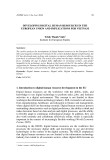
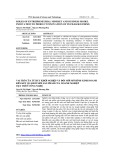
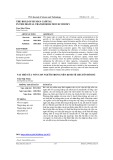
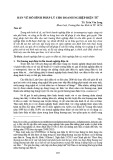
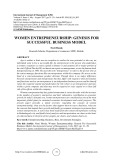
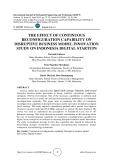












![Bộ câu hỏi trắc nghiệm Đổi mới và sáng tạo [mới nhất]](https://cdn.tailieu.vn/images/document/thumbnail/2025/20251007/kimphuong1001/135x160/56111759828894.jpg)


